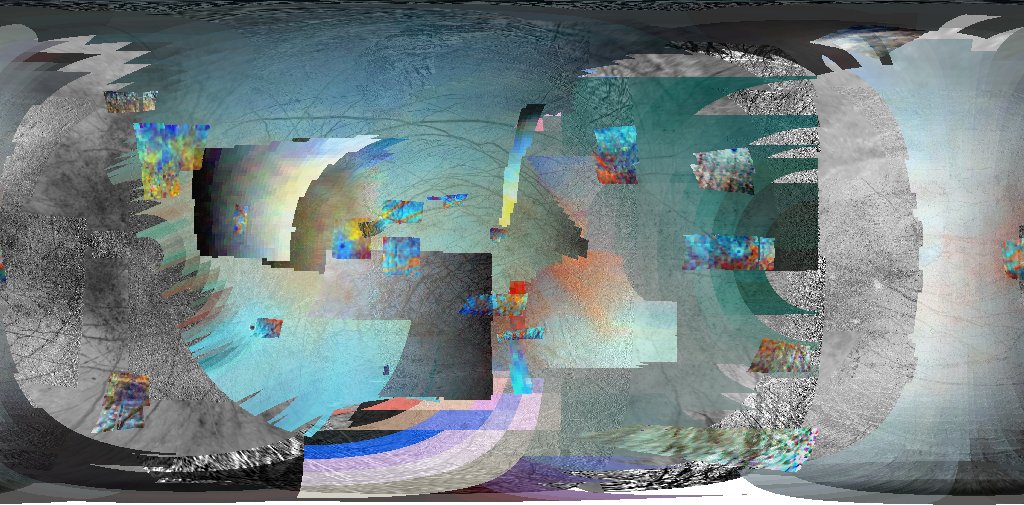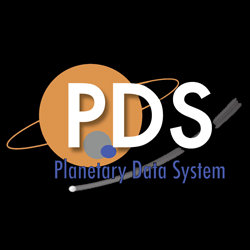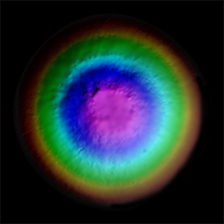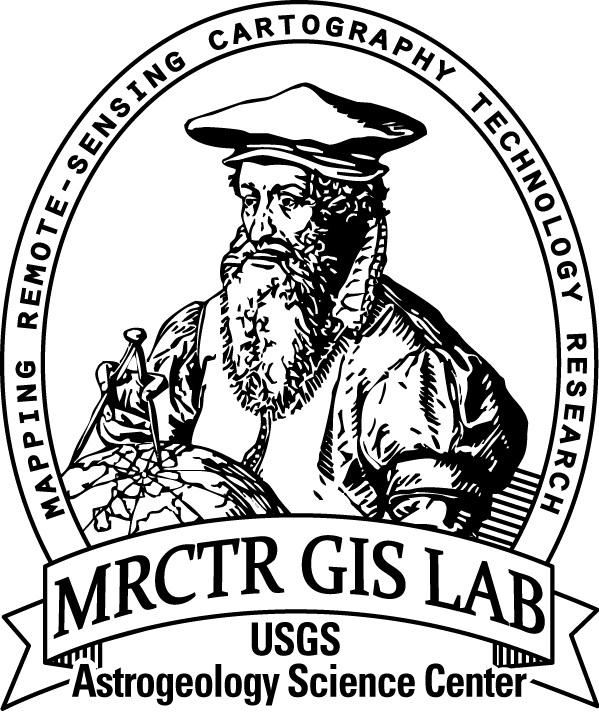Europa Galileo NIMS Hyperspectral Map Products Registered Archive
- Primary Authors
- Malaska, Michael J., Valenti, Mario, Davies, Ashley G., Shirley, James B., Phillips, Cynthia, Fraeman, Abigail, Galbert, Valeria, Lopes, Rosaly M.C., Prockter, Louise, Cahill, Josh T.S., Becker, Kris
- Originators
- Jet Propulsion Laboratory, SETI Institute, Johns Hopkins University Applied Physics Laboratory, University of Arizona
- Publisher
- Planetary Data System
- Publication Date
- 2024-07-25
- Abstract
- These new NIMS map cubes (rasters) of Europa come in three varieties: CUB, CIOF, and COC. The CUB files contain the original spectral radiance values in units of mW/(cm2 str μm). The CIOF files have been converted to radiance I/F units (reflectance). The COC files contain the “backplanes” where each band contains key housekeeping data, such as latitude, longitude, range to target, and incidence angle. For all observations, both registered and unregistered versions of these files are provided. The unregistered versions and the ground control points used for registration are provided so that users can modify the registration or the original spectral-corrected data with minimal spatial modification. The unregistered and registered NIMS map products are provided as multi-band .tiff files in or near the original acquired sub-spacecraft point orthographic projection. They can be directly read into common GIS programs (Esri’s ArcGIS, NV5 Geospatial's ENVI, QGIS) and pixel values interrogated with those software tools. These NIMS products have been registered to the 2010 version of the USGS Europa 500 m V2 mosaic base map (Becker et al., 2010). The user is encouraged to look at the NIMS Encounter Guides (Davies et al., 2022) for explanation of dropouts or spurious readings in some observations (such as 25ENGLOBAL01, when playback was interrupted and not all data in all bands were returned). Background: The Near Infrared Mapping Spectrometer (NIMS) dataset is comprised of a series of local, regional, and global hyperspectral (0.7 to 5.2 μm) observations taken by the Galileo Near Infrared Mapping Spectrometer (NIMS) (Carlson et al. 1992) of Europa’s surface. These products are useful for determining the spatial variation of surface spectra which in turn may indicate compositional or physical changes across Europa’s surface. Correlation of spectral changes with surface morphologies (bands, craters, chaos terrain, low albedo plains, ridged plains) or leading/trailing dichotomies can provide additional information on composition and surface processes. This experiment provided key spectral information in the near-infrared range that enabled determination and constraints on surface composition and correlation with features observed in visual wavelengths by the Solid State Imager experiment (SSI) (Belton et al., 1992). NIMS data are the highest spatial resolution observations in the near infrared (0.7 to 5.2 μm) obtained of Europa’s surface, and will not be surpassed in quality and coverage until Europa is visited by future missions such as NASA’s Europa Clipper and ESA’s JUICE, providing important context, allowing for searches for surface change on a multi-decadal timeline, and as a vital mission planning tool. At its best, when fully operating, NIMS had a spectral resolution of 25 nm. The NIRSpec instrument on the James Webb Space Telescope (JWST) has a spectral resolution that is far greater, at 0.9 nm. NIRSpec has a wavelength range of 0.9 to 3 um. JWST imaged Europa in 2023. The high spatial resolution NIMS data provide vital context for interpreting the higher spectral resolution NIRSpec data. In particular, the water ice band and high infrared reflectance of non-ice materials is evident. Previous researchers have registered these data and combined the resulting products with mapping to examine spectral classification and composition of surface units. DOI: 10.17189/4sz4-5024 Reference: Becker, T., B. Archinal, T. Colvin, M. Davies, A. Gitlin, R. Kirk, L. Weller (2010) Europa Voyager - Galileo SSI Global Mosaic 500m v2, US Geological Survey, Europa_Voyager_GalileoSSI_global_mosaic_500m Belton, M. J. S., K. P. Klaasen, M. C. Clary, J. L. Anderson, C. D. Anger, M. H. Carr C.R. Chapman, M. E. Davies, R. Greeley and D. Anderson (1992) The Galileo Solid-State Imaging experiment, Space Sci. Rev. 60, 413-455, doi.org/10.1007/BF00216864. Carlson, R. W., P. R. Weissman, W. D. Smythe, and J. C. Mahoney, and the NIMS Science and Engineering Teams (1992), Near-Infrared Mapping Spectrometer experiment on Galileo, Space Sci. Rev. 60, 457–502. doi:10.1007/BF00216865. Davies, A. G., Leader, F., & McAuley, J. M. (2022). Galileo NIMS Encounter Guides in PDF format [Dataset]. NASA Planetary Data System. doi.org/10.17189/785f-ct98.
- Purpose
- To spatially register the individual NIMs observations to a modern Europa image mosaic for comparison and analysis.
Contact and Distribution
- Format
- Archive, Data, Image, Raster Data, Remote-sensing Data
- Access Constraints
- None
- Access Scope
- PDS
- Use Constraints
- Please cite authors
- Supplemental Information
- https://astrogeology.usgs.gov/search/map/Europa/Voyager-Galileo/Europa_Voyager_GalileoSSI_global_mosaic_500m
- Native Data Set Environment
- ESRI Arcinfo, GDAL
- Astrogeology Theme
- Cartography, Control Network, Flyby missions, Geographic Information System (GIS), Hyperspectral, Image Processing, Remote Sensing
- Mission Names
- Galileo
- Instrument Names
- NIMS, SSI
- Digital Product?
- yes
- Online Package Link
- https://astrogeology.usgs.gov/search/map/europa-galileo-nims-hyperspectral-map-products-registered-archive#open
- External File Size
- PDS4 archive
- Online File Link
- https://pdsimage2.wr.usgs.gov/Individual_Investigations/europa_go_nims_reprojected_malaska_2023/
- Access Instructions
- https access from the available AWS cloud S3 bucket. AWS S3 commands can be used to download.
- Contact Email
- astroweb@usgs.gov
Data Status and Quality
- Time Period of Content (start)
- 1995-10-09
- Time Period of Content (stop)
- 2003-09-21
- Currentness Reference
- Ground condition
- Progress
- Complete
- Update Frequency
- As needed
- Logical Consistency
- The registered files can be imported directly into ENVI, ArcGIS, and QGIS. As long as the software’s transformation algorithm is correct for that body and projection, they will accommodate “on the fly” reprojection for those datasets. Products ingested into ArcGIS have been re-projected into Europa 2000, Europa Equirectangular, and various test orthogonal projections. It is important to note that the latitude and longitude values obtained at the time of observation and listed in the PDS used an older Europa shape model and do not precisely match the 2010 USGS grid. Our registration process attempts to correct these offsets and align the NIMS dataset to the 2010 USGS grid. However, during this process, some pixel rectification occurred. It is noted that the despiking algorithms both smooths and shifts some of the spectral data even outside wavelengths where spikes are apparent. This was beyond the scope of this project but is noted for the user. The intermediate processing products are provided where possible so the user may select the best for their purposes.
- Completeness Report
- See archive documentation for a listing of images processed and released here.
- Process Description
- The NIMS datafiles were retrieved from unprojected data (tubes) using a combination of calibration files and parameters from the PDS, that were stored on MIPL and converted and calibrated to a point projected but unregistered image product in point projection, then registered in ArcGIS to the USGS base map. See Archive documentation for more. For the different products, the type of processing is appended to the observation name with an underscore separator. Despiked versions have a “SPK” designator, Minnaert-corrected have a “MINN” designator, and despiked and Minnaert-corrected have a ‘SPK_MINN” designator. If no designator is present, it indicates that no additional processing was performed. The next indicator shows the version number of processing during calibration. These are an “MV#” with “1” indicating the first calibration attempt. The different datatype versions are then appended to the file name. The versions are CUB, COC, and CIOF. CUB is radiance values, CIOF is normalized reflectance, and COC lists the backplanes data. The COC backplanes data is the same for each processing type, but the filenames have been duplicated for convenience.
Lineage
- Process Date
- 2024-06-28
- Source Name or Organization
- Planetary Data System
- Source Publication Date
- 2003-09-21
- Source Title
- Galileo Orbiter Near Infrared Mapping Spectrometer (NIMS) Archive
- Source Online Linkage
- https://pdsimaging.jpl.nasa.gov/data/galileo/galileo_orbiter/
- Source PDS Archive
- Galileo
- PDS Status
- PDS 4 Archived
- Type of Source Media
- Online
Geospatial Information
- Target
- Europa
- System
- Jupiter
- Minimum Latitude
- -90
- Maximum Latitude
- 90
- Minimum Longitude
- 0
- Maximum Longitude
- 360
- Direct Spatial Reference Method
- Raster
- Object Type
- Pixel
- Bit Type (8, 16, 32)
- 32
- Radius A
- 1564130
- Radius C
- 1560930
- Control Net
- USGS Europa 2010 global mosaic (Becker et al., 2010)
- Horizontal Coordinate System Units
- Meters
- Map Projection Name
- Orthographic
- Latitude Type
- Planetocentric
- Longitude Direction
- Positive East
- Longitude Domain
- 0 to 360
















